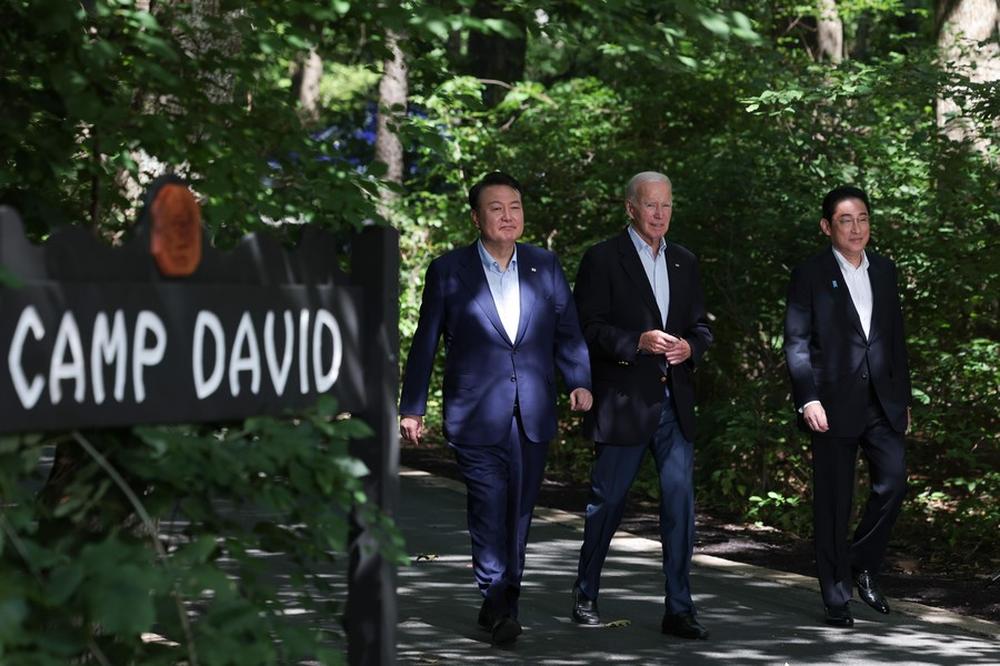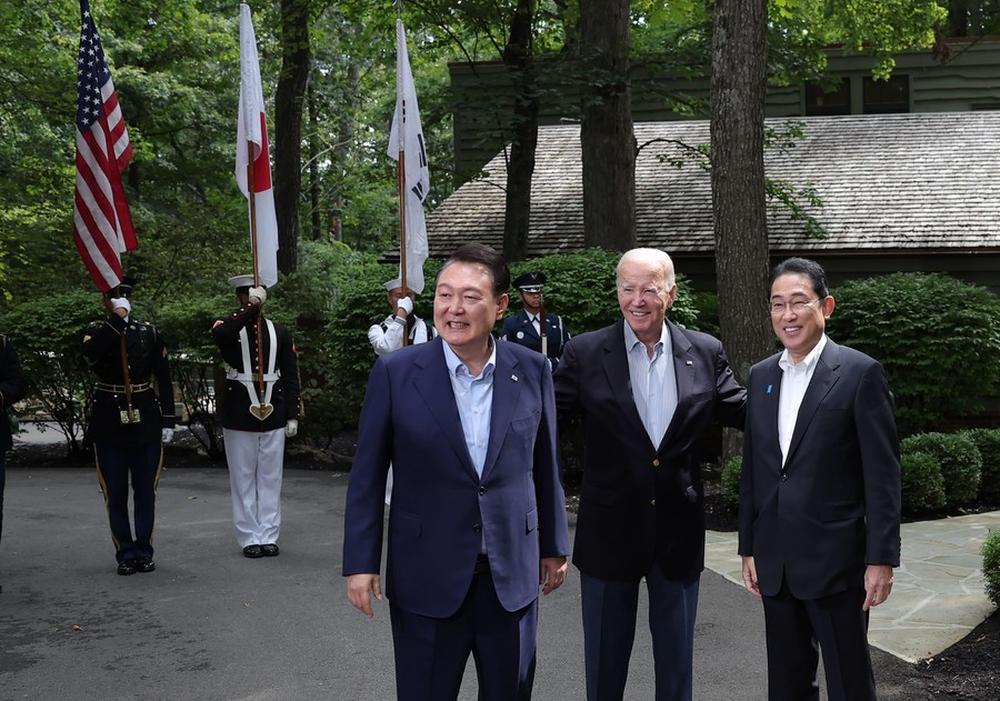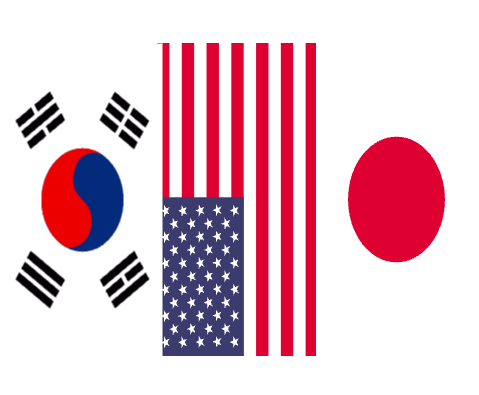- #Global Issues
- #Japan
- #North Korea
- #South Korea
- #US-ROK Alliance

▶ What drives this historic trilateral summit, what do they have in common, and which expected utilities does it have?
▶ The structural variable-the New Cold War-and the catalytic actor-three leaders’ vision-makes it feasible in a situation where the three countries have a lot in common. Thus, this trilateral summit is abundant in a raft of expected utilities such as a security guarantor for countering North Korea and a function of new minilateral architecture for addressing global challenges and complex crisis.
The Outlook of Trilateral Summit and Three Puzzles
International society as well as people of three countries pays tremendous attention to the upcoming trilateral summit between South Korea, the U.S., and Japan, which will be held at Camp David on 18 August 2023. Their attention is growing because the venue is so unique and, further, this meeting will go down in history as the first time that the three leaders meet only for a trilateral summit, not on the opportunity of multilateral meetings. This summit is unprecedented and paves the way for the new minilateral architecture. Thus, this paper attempts to trace and address three puzzles: drivers, something in common, and expected utilities.
The First Puzzle: Drivers
The first puzzle should be what leads to this historic moment. The emergence of this remarkable momentum is attainable through a mechanism in which a structural factor meets an analytic factor. On the one hand, a structural factor is based on changing international politics under the New Cold War. The New Cold War makes the struggle or competition between a status-quo power and revisionists more intense. Under the New Cold War, a relatively stable international order which had maintained ever since WWII is at stake now, particularly in a situation where revisionist states such as near-peer competitors pose a challenge to the liberal international order and the rules-based international order.
To top it off, as the New Cold War mechanism is growing, the UN (United Nations) Security Council has come to a halt. North Korea has been intensifying its nuclear capabilities as shown by the recent launch of the most advanced ICBM (Inter-Continental Ballistic Missile), Hwasong-18. The UN Security Council, however, fails to adopt resolutions for punishing these provocations, as two permanent members, China and Russia, wield veto in their efforts to seize the initiative of great power competition under the New Cold War. How to fill the gap created by the little function of the UN Security Council serves as a quagmire in international politics. The upgraded G7 platform could be one of the possible remedies. To that end, several forms such as G8 or G9 can be taken into consideration, which includes South Korea. In line with these efforts, a trilateral summit might serve as a golden opportunity to fill this gap more practically in the sense that the three states are more able to be cooperative against North Korea’s provocations.
Meanwhile, this structural driver alone would have failed to lead to this historic meeting without a catalytic driver. The three leaders, President Yoon Suk Yeol of South Korea, President Joe Biden of the U.S., and Prime Minister Fumio Kishida of Japan, play a key role in catalytic drivers. In particular, President Yoon initiated this process by visiting Tokyo for a bilateral summit, which, in return, led Prime Minister Kishida to visit Seoul. As shuttle diplomacy gets back on track, the trilateral summit, including President Biden, has begun to fully function. The U.S. has been keen on promoting trilateral cooperation to grapple with international challenges. Accordingly, the emergence of this new platform helps the ROK-U.S. alliance be more cohesive thanks to South Korea’s active role in improving relations with Japan. This process can be conceptualized as fusion diplomacy in the sense that bilateral cooperation turned out to promote trilateral cooperation in a synergistic way.
The Second Puzzle: Something in Common
The second question needs to be asked on what these three countries have in common because trilateral cooperation would be attainable thanks to their commonalities. First, these three countries have a lot in common in terms of ‘willingness’. They are enthusiastic about making universal rights such as human rights widespread around the world since they are all liberal democracies. Second, they put more emphasis on making the principle based on freedom continue to work. They believe that free competition, freedom of speech, and freedom of navigation should be preserved around the world. Furthermore, these three countries are more willing to preserve liberal and rules-based international order in the era of the New Cold War. These commonalities vis-à-vis willingness lead to their strategic cooperation. In this vein, South Korea’s Indo-Pacific Strategy is most likely to be more fruitful when trilateral cooperation is more viable.
Simultaneously, the three states have a lot in common in terms of ‘capability’ as well. The U.S. is a world-leading country in terms of hard and soft powers. Both South Korea and Japan are developed and prosperous countries as well. A high degree of capabilities means that they are able to mobilize resources enough to make their willingness be converted to feasible policies around the world.
These commonalities of both willingness and capabilities encourage the three countries to be more binding in their efforts to preserve liberal international order and make their visions more attainable.
The Third Puzzle: Expected Utilities
Finally, the third puzzle focuses on what this summit is expected to achieve. To put it another way, which expected utilities are there in this summit? To start with, the historic trilateral summit helps step up their efforts to offset North Korea’s nuclear provocations. This summit is expected to contribute to making GSOMIA (General Security of Military Information Agreement) and TISA (Trilateral Information Sharing Arrangement) more functional and grapple with North Korea’s ambitions more effectively. More detailed-operational procedures are expected to be laid out for countering North Korea.
Second, the trilateral summit could serve as an opportunity for taking an initial step to prepare for consolidated cooperation in the UN Security Council next year. In 2024, South Korea, the U.S., and Japan are scheduled to play a role in the UN Security Council all together. Since it is a golden chance, they need to early prepare for how to cooperate in this venue.
Third, its expected utility can be found from the viewpoint of the role model for minilateralism. This summit could pave the way for the most relevant platform for minilateral cooperation. The New Cold War dynamics motivated minilateralism to be at the forefront because its role is recognized for addressing a raft of challenges around the world. Similar to other types of minilateralism-based platforms such as QUAD and AUKUS, the minilateral platform of ROK-US-Japan has the potential to play a major role in preserving rules-based order around the world. To that end, this platform needs to be evolved into a more binding one while being held periodically.
Conclusion: Which Roads are Ahead of them?
If this trilateral summit is valuable like the above, what needs to be done for sustainability and performance? First, trilateral meeting needs to be institutionalized as it is held periodically and their meeting types made more diverse into working groups to make agreements from summits be implemented in a timely manner. Why? This historic summit became attainable to the three leaders’ visions and their individual characteristics although this cooperation remains inevitable in a structural sense. What it means is that this bond could be vulnerable to the domestic politics of each country. Accordingly, they need to make this platform more formalized and more institutionalized in order not to be swayed by changing domestic politics.
Second, how to mitigate the New Cold War mechanism needs to be taken into consideration from the viewpoint of policies. If the trilateral summit is recognized to promote the New Cold War mechanism, it will be not only disadvantageous for achieving the expected outcome but also face strategic deadlock. Thus, the trilateral summit needs to adopt the concept of absolute gain in some areas. One reference point could be examined from inclusiveness adopted as one of three cooperation principles by South Korea in its Indo-Pacific Strategy. Likewise, this new trilateral architecture should be far from formalized alliance based on collective defense.
Finally, this summit needs to serve as an opportunity to expand agendas for cooperation. Three countries have already agreed to cooperate with many agendas through the Phnom Penh Statement in November 2022, which include a raft of areas for cooperation such as countering North Korea, supporting Ukraine, maintaining peace in Taiwan, and Indo-Pacific prosperity. As three leaders step up the above efforts, they need to focus on additional agendas, which includes cooperation for the success of the third Summit for Democracy, more systemic cooperation for promoting solidarity with the Pacific Islands, and collective economic security based on trilateral cooperation against economic coercion. With agendas expanding, the trilateral summit will be able to evolve into a global security and economic architecture for addressing global challenges and complex crises.
Dr. Kil Joo Ban is a Research Professor at Ilmin International Relations Institute, Korea University. He has a Ph. D. in Political Science from Arizona State University (2011). His research areas are the U.S.-China competition, Asian security, alliance, diplomatic & military strategy, North Korea’s nuclear program and middle power politics. He has published 6 books including 2 co-authored books and has written more than 50 academic articles. Recent articles are “An Invisible Strategy with Visible Gains: Gray Zone Strategy of the Northeast Asian States and Challenges to South Korea,” Korea Observer (2023) “Arms Control Dialogue or Gray Zone Talks? Pitfalls of the Discourses of Denuclearization of the Korean Peninsula and Nuclear Arms Control,” Pacific Focus (2022), “Lopsided Security on the Korean Peninsula: North Korea’s Gray Zone Evolution from Balance of Insecurity to Imbalance of Terror,” Asian Survey (2021), and “Aircraft Carrier Balancing in Northeast Asia and South Korean Carrier Program: Power, Threat, and Function,” The Korean Journal of Defense Analysis (2021).



